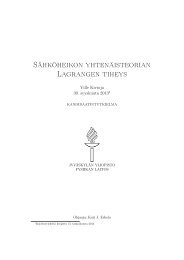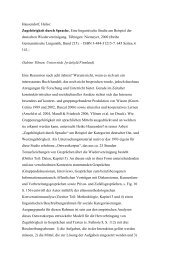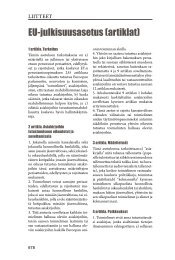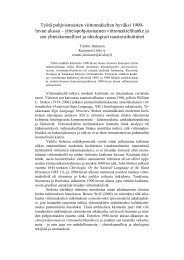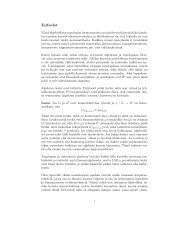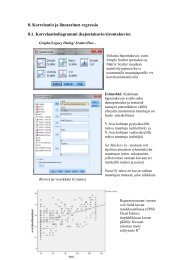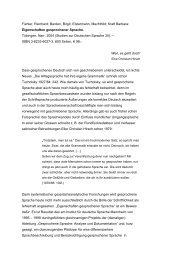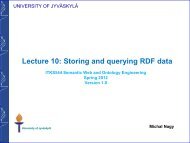Chapter 3: The ground case
Chapter 3: The ground case
Chapter 3: The ground case
Create successful ePaper yourself
Turn your PDF publications into a flip-book with our unique Google optimized e-Paper software.
<strong>The</strong>ory of Automated Reasoning<br />
An Introduction<br />
Antti-Juhani Kaijanaho
Intended as compulsory reading for the Spring 2004 course on<br />
Automated Reasononing at Department of Mathematical<br />
Information Technology, University of Jyväskylä.
CHAPTER 3<br />
<strong>The</strong> Ground Case<br />
1. Sentential language 23<br />
2. From <strong>ground</strong> to sentential formulae 26<br />
3. Clausal forms 28<br />
4. Inference in the sentential language 31<br />
4.1. Semantic tableaux 31<br />
4.2. Davis–Putnam procedure 34<br />
4.3. Sentential resolution 36<br />
4.4. On heuristics 36<br />
1. Sentential language<br />
METADEFINITION 3.1 (Sentential language). Let V be a first-order<br />
vocabulary containing at least one constant symbol and at least one<br />
predicate symbol and let p be a well-formed <strong>ground</strong> formula in the<br />
first-order language over V. Now, let q1, . . . , qn be a permutation of<br />
the atomic subformulae of p and let x1, . . . , xn be a n-permutation<br />
(permutation of any n elements) of V . We rewrite p by replacing in<br />
it each atomic subformula qi with the corresponding variable xi. <strong>The</strong><br />
set of results of this rewrite for every possible such permutations is<br />
denoted Pp. We now call the set F = { q ∈ Pp | p ∈ FV } ∪ {⊤, ⊥}<br />
a sentential language and its members (well-formed) sentential formulae.<br />
When used in this context, the elements of the set V are called<br />
sentential variables.<br />
For sentential formulae p and q, we denote by p[q/x] the formula<br />
obtained from p by replacing all occurrences of the variable x with q.<br />
It is important to understand the difference in function between<br />
a variable in a first-order language and a sentential variable. In firstorder<br />
languages, variables are placeholders for terms, but in sentential<br />
languages, variables are placeholders for formulae.<br />
<strong>The</strong> formula ⊤ is pronounced verum and the formula ⊥ falsum.<br />
<strong>The</strong>y are sentential constants.<br />
METAPROPOSITION 3.2. All sentential languages are identical: if L<br />
and L ′ are sentential languages, then L = L ′ holds.<br />
PROOF. Left as an exercise. <br />
23
24 3. THE GROUND CASE<br />
Since all sentential languages are identical, it makes sense to think<br />
that there is only one and speak of the sentential language. <strong>The</strong> sentential<br />
language has many names: popular names are propositional<br />
language, propositional calculus and propositional logic. Authors who<br />
use these names also tend to call sentential formulae propositions and<br />
sentential variables propositional variables. <strong>The</strong> name “sentential language”<br />
refers to its apparent usefulness in analysing the structure of<br />
complex declarative sentences in natural languages.<br />
METADEFINITION 3.3 (Semantics of the sentential language). A<br />
general truth valuation is a function f from the sentential language to<br />
{0, 1} obeying the following equations of informal arithmetic (where<br />
p and q are sentential formulae):<br />
(30)<br />
(31)<br />
(32)<br />
(33)<br />
(34)<br />
(35)<br />
(36)<br />
(37)<br />
(38)<br />
(39)<br />
(40)<br />
f (⊤) = 1<br />
f (⊥) = 0<br />
f (¬p) = 1 − f (p)<br />
f (p ∧ q) = f (p) f (q)<br />
f (p ∨ q) = f (p) + f (q) − f (p) f (q)<br />
f (p → q) = 1 − f (p) + f (q)<br />
f (p ← q) = 1 − f (q) + f (p)<br />
f (p ↔ q) = f (p) f (q) + (1 − f (p))(1 − f (q))<br />
f (p | q) = 1 − f (p) f (q)<br />
f (p ↓ q) = (1 − f (p))(1 − f (q))<br />
f (p q) = f (p) + f (q) − 2 f (p) f (q)<br />
Let φ be a truth valuation and p be a sentential formula. We define<br />
φ p as φ(p) = 1 and φ p as φ(p) = 0.<br />
We say that p is true for φ, when φ p holds, and that p is false for<br />
φ, when φ p holds. Further, we say that p is a tautology, denoted<br />
p, if it is true for all possible truth valuations, satisfiable, if it is true<br />
for some (perhaps all) possible truth valuations, unsatisfiable if it is<br />
true for no possible truth valuation and contingent if it is satisfiable<br />
but not a tautology. Two sentential formulae, p and q, are logically<br />
equivalent if p ↔ q is a tautology.<br />
METAPROPOSITION 3.4. Every tautology is logically equivalent to ⊤.<br />
Every unsatisfiable formula is logically equivalent to ⊥.<br />
PROOF. Trivial. <br />
A truth table is essentially a tabular presentation of the above definition.<br />
We can develop a truth table (Table 1) for each connective by<br />
observing how the truth of each one-connective sentential formula<br />
behaves with respect to the truth of its sentential variables.
1. SENTENTIAL LANGUAGE 25<br />
p q ¬p p ∧ q p ∨ q p → q p ← q p ↔ q p | q p ↓ q p q<br />
1 1 0 1 1 1 1 1 0 0 0<br />
1 0 0 0 1 0 1 0 1 0 1<br />
0 1 1 0 1 1 0 0 1 0 1<br />
0 0 1 0 0 1 1 1 1 1 0<br />
TABLE 1. <strong>The</strong> basic truth table<br />
Truth tables present us with a simple but expensive algorithm for<br />
checking for satisfiability and tautologiness. But first, let us define<br />
some convenient notation.<br />
METADEFINITION 3.5. Let P be a nonempty finite set of sentential<br />
formulae. Now, we define V P as f (1) ∧ · · · ∧ f (n) and W P as<br />
f (1) ∨ · · · ∨ f (n), where n is the size of P and f is any injection from<br />
{1, . . . , n} to P. We further define V ∅ as ⊥ and W ∅ as ⊤.<br />
METAPROPOSITION 3.6. <strong>The</strong> new operators V and W are well-defined;<br />
that is, regardless of how f is chosen, the result is the same.<br />
PROOF. Follows from associativity and commutativity of conjunction<br />
and disjunction. <br />
METAPROPOSITION 3.7. Let P be a finite set of sentential formulae<br />
and let p be a sentential formula not in P. <strong>The</strong>n, both<br />
^ P ∪ {p} ≡ p ∧ ^ P<br />
and _ P ∪ {p} ≡ p ∨ _ P<br />
hold.<br />
PROOF. Omitted. <br />
Now, we can give the algorithm.<br />
ALGORITHM 3.8. Let input be a finite set of sentential formulae<br />
P and a sentential formula q. Let p be V P → q (if P is empty,<br />
p is q). Now, let r1, . . . , rn be a permutation of all distinct subformulae<br />
of p where formulae are preceded by their subformulae. Let k<br />
be the number of distinct atomic subformulae of p. Allocate a twodimensional<br />
array with 2 k rows and n columns, both indexed starting<br />
from 1. Do the following for each i = 1, . . . , n (in ascending order<br />
of i).<br />
If i ≤ k holds, fill the column i first with 2 i−1 ones, then with 2 i−1<br />
zeros, then with 2 i−1 ones and so on until the whole column is filled.<br />
Otherwise, for each j = 1, . . . , 2 k , look up the cells at row j, column as<br />
corresponding to each of the immediate subformulas of the formula<br />
ri, and use them to look up the correct row in Table 1, then copy the
26 3. THE GROUND CASE<br />
value from that row at the column corresponding to the formula ri<br />
to the array at row j, column i.<br />
Finally, check if the nth column of the array contains any ones. If<br />
not, output unsatisfiable. Otherwise, check if it contains any zeros. If<br />
not, output tautology, otherwise output contingent.<br />
METAPROPOSITION 3.9. Algorithm 3.8 is correct (i.e. terminates normally<br />
for all valid inputs and produces the correct result whenever it terminates<br />
normally).<br />
PROOF. Omitted. <br />
2. From <strong>ground</strong> to sentential formulae<br />
Recall that a <strong>ground</strong> term is a term which contains no variables,<br />
bound or free, and no ɛ-terms. Likewise, a <strong>ground</strong> formula contains<br />
no variables, bound or free, and no quantifiers. Ground terms can<br />
generally be ignored, since they are effectively constants. Ground<br />
formulae are more interesting, as can be seen from the following<br />
metadefinitions and metapropositions:<br />
METADEFINITION 3.10. Formulae of the form (3, r, t1, . . . , ta(r)) (in<br />
other words, r(t1, . . . , ta(r))) are called atomic formulae. If p ∈ f (q) holds<br />
for the f of Definition 2.12, then p is a subformula of q.<br />
METAPROPOSITION 3.11. All formulae contain at least one atomic<br />
subformula.<br />
PROOF. This is evident from the definition of a formula (atomic<br />
formulae form the base <strong>case</strong> of the recursion). Note that a formula is<br />
a subformula of itself, and hence this holds also for atomic formulae.<br />
<br />
METALEMMA 3.12. For every well-formed <strong>ground</strong> formula p, its extension<br />
p M in any model M is either U or ∅.<br />
PROOF. Evident from the fact that no variables are present in<br />
<strong>ground</strong> formulae. <br />
<strong>The</strong> following proposition is the key to combining <strong>ground</strong> formulae<br />
and sentential formulae.<br />
METAPROPOSITION 3.13 (Truth-functionality). A well-formed <strong>ground</strong><br />
formula is a truth function of its atomic subformulae: for each well-formed<br />
<strong>ground</strong> formula p with its atomic subformulae being q1, . . . , qn (possibly<br />
containing duplicates), there is a function f : {0, 1} n → {0, 1} such that for<br />
every model M, the assertion M p holds if and only if f (b1, . . . , bn) = 1<br />
holds, where each bi is 1 if and only if M qi holds, and 0 otherwise.<br />
<strong>The</strong> function f is called the truth function of the formula and the<br />
bi are called the truth values of the atomic subformulae.
2. FROM GROUND TO SENTENTIAL FORMULAE 27<br />
PROOF. We proceed by structural induction.<br />
(1) Let p be atomic. <strong>The</strong>n clearly n = 1 and qi = p hold. <strong>The</strong><br />
required function f is thus the identity function in {0, 1}.<br />
Other possible functions are obtained by defining f (b1, . . . , bn) =<br />
f (b1), where bi = b j holds.<br />
(2) Let p be ¬q with b1, . . . , bn being the truth values atomic subformulae<br />
of q. Note that they are also the atomic formulae<br />
of p. Let M be a model where M q holds. By definition<br />
q M = U holds. ¬q M = ∅ holds, and so M ¬q holds.<br />
Let M be a model where M q holds. By definition and<br />
lemma 3.12, q M = U holds. Now, therefore, ¬q M = ∅. A<br />
suitable f for p is, therefore,<br />
(b1, . . . , bn) ↦→<br />
<br />
1 if g(b1, . . . , bn) = 0<br />
0 if g(b1, . . . , bn) = 1<br />
where g is a truth function for q. Other suitable functions<br />
can be obtained by permuting the atomic subformulae, and<br />
by removing or adding duplicate atomic subformulae.<br />
(3) Let p be q ∧ r with b1, . . . , bm being the atomic subformulae<br />
of q and bm+1, . . . , bn (where m < n holds) being the atomic<br />
subformulae of r. <strong>The</strong>re are four <strong>case</strong>s:<br />
(a) Let M be a model where M p and M q hold. <strong>The</strong>n,<br />
q ∧ r M = q M ∩ r M = U ∩ U = U holds.<br />
(b) Let M be a model where M p and M q hold. <strong>The</strong>n,<br />
q ∧ r M = q M ∩ r M = U ∩ ∅ = ∅ holds.<br />
(c) Let M be a model where M p and M q hold. <strong>The</strong>n,<br />
q ∧ r M = q M ∩ r M = ∅ ∩ U = ∅ holds.<br />
(d) Let M be a model where M p and M q hold. <strong>The</strong>n,<br />
q ∧ r M = q M ∩ r M = ∅ ∩ ∅ = ∅ holds.<br />
(b1, . . . bn) ↦→<br />
<strong>The</strong>refore, for p, a suitable f is<br />
<br />
1 if fq(b1, . . . , bm) = 1 and fr(bm+1, . . . , bn) = 1 hold<br />
0 otherwise<br />
where fq and fr are the truth functions of q and r, respectively.<br />
Other suitable functions can be obtained by permuting<br />
the atomic subformulae, and by removing or adding duplicate<br />
atomic subformulae.<br />
(4) Other <strong>case</strong>s are taken care of the above due to Metaproposition<br />
2.22 <strong>case</strong> 3.<br />
METACOROLLARY 3.14. <strong>The</strong> above result holds even if some or all of<br />
qi are replaced with non-atomic subformulae as long as every atomic subformula<br />
is a subformula of some qi.
28 3. THE GROUND CASE<br />
PROOF. We can split the induction into two by introducing artificial<br />
base <strong>case</strong>s before encountering an atomic subformula, as long as<br />
we can reach every atomic subformula by continuing induction. <br />
Now, the following proposition allow us to move freely between<br />
first-order <strong>ground</strong> formulae and sentential formulae:<br />
METAPROPOSITION 3.15. For every first-order structure M there is a<br />
truth valuation φ such that for every <strong>ground</strong> formula p and every sentential<br />
formula p ′ generated from p as in Definition 3.1, M p holds whenever<br />
φ p holds, and vice versa.<br />
PROOF. Left as an exercise. <br />
METACOROLLARY 3.16. <strong>The</strong>re is a sound inference system that is<br />
complete and decidable for <strong>ground</strong> formulae (i.e. where any valid <strong>ground</strong><br />
formula is a theorem and any refutable <strong>ground</strong> formula is a nontheorem).<br />
PROOF. Use the truth table method, translating <strong>ground</strong> formulae<br />
into sentential formulae at input and translating tautologiness into<br />
theoremhood and unsatisfiability and contingence into nontheoremhood.<br />
<br />
3. Clausal forms<br />
METADEFINITION 3.17 (Clausal forms). Any sentential formula<br />
that is a sentential variable or ⊤ is a positive literal. Any sentential<br />
formula that is a negation of a sentential variable or ⊥, is a negative<br />
literal. Positive literals and negative literals are all literals. <strong>The</strong> complement<br />
of a negative literal ¬x or ⊥ is the corresponding positive<br />
literal x or ⊤; conversely, the complement of a positive literal x or ⊤<br />
is the corresponding negative literal ¬x or ⊥. Two literals are complementary<br />
if they are each others’ complements. A formula that is not<br />
a literal is a nonliteral.<br />
A finite set of literals is called a clause and a dual clause.<br />
A set of clauses C is a clause form of a sentential formula p if p ≡<br />
V W C holds. A set of dual clauses C is a dual clause form of p if p ≡<br />
W V C holds.<br />
<strong>The</strong> reason for two names for the same thing is that they suggest<br />
different interpretations. A set of literals that is a clause is always<br />
interpreted as a disjunction of the literals, whereas a dual clause is<br />
always interpreted as a conjunction of its literals. Similarly, a set of<br />
clauses is interpreted as a conjunction of the disjunctions that the<br />
clauses are, and a set of dual clauses is interpreted as a disjunction<br />
of the conjunctions that the clauses are. This is also evident from the<br />
definitions of clause and dual clause forms.<br />
We denote the complement of a literal ℓ by ¯ℓ.
3. CLAUSAL FORMS 29<br />
α α1 α2 β β1 β2<br />
¬¬p p p<br />
p ∧ q p q ¬(p ∧ q) ¬p ¬q<br />
¬(p ∨ q) ¬p ¬q p ∨ q p q<br />
¬(p → q) p ¬q p → q ¬p q<br />
¬(p ← q) ¬p q p ← q p ¬q<br />
p ↔ q p ← q p → q ¬(p ↔ q) ¬(p ← q) ¬(p → q)<br />
¬(p | q) p q p | q ¬p ¬q<br />
p ↓ q ¬p ¬q ¬(p ↓ q) p q<br />
¬(p q) p ← q p → q p q ¬(p ← q) ¬(p → q)<br />
TABLE 2. Lis–Smullyan uniform notation for sentential<br />
formulae<br />
METATHEOREM 3.18. Every sentential formula has both a clause form<br />
and a dual clause form.<br />
We will prove this theorem by giving algorithms that construct a<br />
clause form or a dual clause form of a sentential formula. To present<br />
these algorithms concisely, we need a uniform notation independently<br />
discovered by Lis and Smullyan in the 1960s. <strong>The</strong> basic idea<br />
of this notation comes from the observation that every nonliteral formula<br />
can be though as essentially conjunctive or essentially disjunctive<br />
(in fact, as noted earlier, all sentential formulae can be written<br />
with just negation, conjunction and disjunction). Now, every nonliteral<br />
is categorized either as an α-formula (essentially conjunctive<br />
formula) or as an β-formula (essentially disjunctive formula), associating<br />
with each α-formula a pair of decomposition formulas α1 and<br />
α2 such that α ≡ α1 ∧ α2 holds, and associating with each β-formula<br />
a pair of decomposition formulas β1 and β2 such that β ≡ β1 ∨ β2<br />
holds. In any formula, α denotes an arbitrarily chosen α-formula,<br />
and α1 and α2 are the α1 and α2 of that formula. Likewise, β denotes<br />
an arbitrarily chosen β-formula, and β1 and β2 are the β1 and<br />
β2 of that formula. Table 2 shows how formulae are categorized and<br />
decomposed.<br />
ALGORITHM 3.19 (Clause form). Let the input be a sentential formula<br />
p and let r be {{p}}. Now, for as long as S r contains at least<br />
one nonliteral, repeat the following:<br />
(1) Choose a nonliteral-containing member from r; let it be c.<br />
(2) Choose a nonliteral from c.<br />
(3) If the chosen formula was ¬¬q for some q, update r to be<br />
r ′ ∪ {c ′ ∪ {r}}, where r ′ is r \ {c} and c ′ is c \ {α}.<br />
(4) If some other α-formula was chosen, update r to be r ′ ∪ {c ′ ∪<br />
{α1}, c ′ ∪ {α2}}, where r ′ is r \ {c} and c ′ is c \ {α}.
30 3. THE GROUND CASE<br />
(5) If a β-formula was chosen, update r to be r ′ ∪ {c ′ ∪ {β1, β2}},<br />
where r ′ is r \ {c} and c ′ is c \ {β}.<br />
<strong>The</strong> output is the final update of r.<br />
METAPROPOSITION 3.20. Algorithm 3.19 terminates for all inputs<br />
regardless of how choices are made.<br />
PROOF. Let n be the number of nonliteral subformulae of every<br />
formula in S r. Clearly n is nonnegative at all times, and clearly the<br />
algorithm terminates if and only if n = 0 holds. Now, it remains to<br />
show that every iteration decreases n by at least one. We leave that<br />
as an exercise. <br />
METALEMMA 3.21. <strong>The</strong> output of Algorithm 3.19 is a set of clauses.<br />
PROOF. For simplicity, we assume that the initial state of r is the<br />
input, and that it may contain any number of sets of formulae as<br />
input. <strong>The</strong> actual algorithm is a special <strong>case</strong> of this.<br />
We proceed by induction over the number n of nonliteral subformulae<br />
in formulae of S r. <strong>The</strong> base <strong>case</strong>, n = 0, is trivial: it can only<br />
happen if the input is a set of clauses already, in which <strong>case</strong> the output<br />
is a set of clauses. We now assume that the algorithm outputs a<br />
set of clauses if given as input a set of formula sets containing strictly<br />
less than k nonliteral subformulae. Consider input containing exactly<br />
k nonliteral subformulae. Clearly, n = k holds at the beginning.<br />
Now, as noted in the previous proof, an iteration always decreases n;<br />
we therefore let the algorithm run for one iteration; the proposition<br />
then follows from the induction hypothesis. <br />
METAPROPOSITION 3.22. <strong>The</strong> output of Algorithm 3.19 is a clause<br />
form of its input formula.<br />
PROOF. It suffices to show that V W r ≡ p is a loop invariant, that<br />
is, that it holds in the beginning and that each iteration preserves it.<br />
We leave this as an exercise. <br />
ALGORITHM 3.23 (Dual clause form). Let p be a sentential formula<br />
and let r be {{p}}. Now, for as long as S r contains at least one<br />
nonliteral, repeat the following:<br />
(1) Choose a nonliteral-containing member from r; let it be c.<br />
(2) Choose a nonliteral from c.<br />
(3) If the chosen formula was ¬¬q for some q, update r to be<br />
r ′ ∪ {c ′ ∪ {r}}, where r ′ is r \ {c} and c ′ is c \ {α}.<br />
(4) If some other α-formula was chosen, update r to be r ′ ∪ {c ′ ∪<br />
{α1, α2}}, where r ′ is r \ {c} and c ′ is c \ {α}.<br />
(5) If a β-formula was chosen, update r to be r ′ ∪ {c ′ ∪ {β1}, c ′ ∪<br />
{β2}}, where r ′ is r \ {c} and c ′ is c \ {β}.<br />
<strong>The</strong> output is the final update of r.
4. INFERENCE IN THE SENTENTIAL LANGUAGE 31<br />
METAPROPOSITION 3.24. Algorithm 3.23 is correct, that is, it terminates<br />
for all valid inputs and its output is a dual clause form of its input.<br />
PROOF. Proceeds similarly to the corresponding proofs for the<br />
clause algorithm above. <br />
4. Inference in the sentential language<br />
In this section, we will review several inference systems for the<br />
<strong>ground</strong> <strong>case</strong>, using the sentential language.<br />
4.1. Semantic tableaux. Semantic tableaux are based on the ideas<br />
of Gerhard Gentzen from the 1930s, specifically his sequent calculi.<br />
<strong>The</strong> idea of tableaux was originally discovered by Jaakko Hintikka<br />
and E. W. Beth independently of each other in the 1950s, and was<br />
further refined by Raymond Smullyan in the 1960s (Smullyan called<br />
his version analytic tableaux). Tableaux as an automated reasoning<br />
method was popularized by Smullyan’s student, Melvin Fitting, in<br />
the first edition of his textbook as well as by several successful tableaubased<br />
systems in the early 1990s. <strong>The</strong> presentation here is influenced<br />
by Ben-Aris presentation 1 .<br />
METADEFINITION 3.25 (Labelled trees). A labelled tree is a quintuple<br />
(E, L, r, p, l) for which the following hold:<br />
(1) r ∈ E.<br />
(2) p : (E \ {r}) → E.<br />
(3) For every e ∈ E, there is a finite set {e1, . . . , en} such that e =<br />
en holds, e1 = r holds, p(ei+1) = ei holds for all i = 1, . . . , n − 1,<br />
and ei = e j implies i = j for all i = 1, . . . , n − 1. <strong>The</strong> size of<br />
that set, n, is the depth of the node e.<br />
(4) For no e ∈ E is there a finite set {e1, . . . , en} such that e = en =<br />
e1 holds and p(ei) = ei+1 holds for all i = 1, . . . , n − 1.<br />
(5) l : E → L.<br />
<strong>The</strong> elements of E are called nodes or vertices, the elements of L<br />
are called labels, and the node r is called the root. For each node e, the<br />
node s(e) is called its parent. <strong>The</strong> children of a node are all the nodes<br />
whose parent it is. Two nodes are siblings if they have a common<br />
parent. A node is a leaf if it has no children; all other nodes are<br />
internal. A sequence of nodes is a branch if its first node is the root,<br />
either it is infinite or its last node is a leaf, and each of its nodes is a<br />
parent of the next node. A labelled tree is binary if all its nodes have<br />
at most two children.<br />
1 Mordechai Ben-Ari: Mathematical Logic for Computer Science, Second Edition,<br />
London, Springer, 2001.
32 3. THE GROUND CASE<br />
METADEFINITION 3.26. A (sentential) semantic tableau is any labelled<br />
binary tree whose labels are sets of sentential formulae, satisfying<br />
the following criteria:<br />
(1) <strong>The</strong> root node is labelled with a singleton set.<br />
(2) If a node e has two children, then its label l(e) contains a<br />
β-formula and the labels of the two children e1 and e2 are<br />
l(e1) = (l(e) \ {β}) ∪ {β1} and l(e2) = (l(e) \ {β}) ∪ {β2}.<br />
(3) If a node e has one child e ′ , then there is an α-formula in l(e)<br />
such that l(e ′ ) = (l(e) \ {α}) ∪ {α1, α2} holds.<br />
A leaf node is closed if its label contains complementary literals.<br />
A leaf is incomplete if its label contains nonliterals. A leaf is open if it<br />
is neither incomplete nor closed.<br />
A tableau is incomplete if any of its leaf nodes is incomplete and<br />
complete otherwise; it is closed if all of its leafs are closed; and it is open<br />
if any of its leaf nodes are open.<br />
A tableau is said to be for p, when its root is labelled with the<br />
singleton set {p}.<br />
<strong>The</strong> definition of a tableau suggests an obvious algorithm for its<br />
construction. We will not explicate it here.<br />
METAPROPOSITION 3.27 (Finiteness). Every sentential semantic tableau<br />
is finite.<br />
PROOF. It is sufficient to note that the total number of subformulae<br />
in formulas in the label of each node is strictly smaller than the<br />
corresponding number in the parent node. <br />
METACOROLLARY 3.28 (Computability). <strong>The</strong> problem of constructing<br />
a complete sentential tableau for a sentential formula is computable.<br />
PROOF. Prove using finiteness and the obvious algorithm. <br />
ALGORITHM 3.29 (Tableaux as a refutation procedure). Let the<br />
input be a sentential formula. Construct a closed or complete semantic<br />
tableau for its negation. Output 1 if the tableau is closed and<br />
0 if it is open.<br />
We will now embark in a proof that this algorithm is a decidable,<br />
sound and complete inference system for the sentential language.<br />
METACOROLLARY 3.30 (Decidability of tableaux refutation). Algorithm<br />
3.29 terminates for all inputs.<br />
PROOF. Follows from Metacorollary 3.28. <br />
METADEFINITION 3.31 (Hintikka set). A set H of sentential formulae<br />
is a (sentential) Hintikka set (also known as a downward saturated<br />
set) if the following hold:<br />
(1) For any literal ℓ, if ℓ ∈ H holds, then ¯ℓ ∈ H does not hold.
4. INFERENCE IN THE SENTENTIAL LANGUAGE 33<br />
(2) For any sentential formula p, if ¬¬p ∈ H holds, then p ∈ H<br />
holds.<br />
(3) If α ∈ H holds, then both α1 ∈ H and α2 ∈ H hold.<br />
(4) If β ∈ H holds, then at least one of β1 ∈ H and β2 ∈ H holds.<br />
METADEFINITION 3.32. A set of sentential formulae is satisfiable<br />
if there is a truth valuation in which every formula in the set is true<br />
and unsatisfiable otherwise.<br />
METALEMMA 3.33 (Hintikka’s lemma). Every Hintikka set is satisfiable.<br />
PROOF. Let H be the Hintikka set being considered and let L be<br />
the set of literals in H. Let φ be a truth valuation such that for each<br />
sentential variable x, φ(x) = 1 holds if x ∈ L holds, and φ(x) = 0<br />
holds if ¬x ∈ L holds. Since a Hintikka set does not contain complementary<br />
literal, φ is well-defined, even if it is underspecified (choose<br />
any function that fits). <strong>The</strong> rest of the proof, left as an exercise, then<br />
shows that all members of H are true under φ. <br />
METAPROPOSITION 3.34. Let e1, . . . , en be an open branch of a semantic<br />
tableau. <strong>The</strong>n e1 ∪ · · · ∪ en is a Hintikka set.<br />
PROOF. <br />
METACOROLLARY 3.35 (Tableaux model property). For every open<br />
leaf of a semantic tableaux for p there is a truth valuation that makes p true.<br />
PROOF. Combine the two previous lemmas. <br />
METACOROLLARY 3.36 (Tableau completeness). Algorithm 3.29<br />
outputs 1 for all valid sentential formulae.<br />
PROOF. Assume that the algorithm outputs 0 for a valid formula p.<br />
<strong>The</strong>n, there is an open tableau for ¬p. By Metacorollary 3.35, then,<br />
¬p is satisfiable, which means that p is refutable and hence not valid.<br />
Thus we arrive at a contradiction. <br />
METAPROPOSITION 3.37 (Tableau soundness). If Algorithm 3.29<br />
outputs 1 for a formula, it is valid.<br />
PROOF. It suffices to prove that if a sentential formula p has a<br />
closed tableau, it is unsatisfiable.<br />
We will now prove by structural induction that in all closed tableaux,<br />
every node is labelled with an unsatisfiable set. From this the proposition<br />
follows trivially.<br />
Let e be a leaf node. Since the tableau is closed, the node is closed<br />
and thus l(e) contains complementary literals. <strong>The</strong>refore, l(e) is unsatisfiable.<br />
Let e be a node with one child e ′ . We make the induction assumption<br />
that l(e ′ ) is unsatisfiable. Now, by definition, l(e ′ ) = (l(e) \ {α}) ∪
34 3. THE GROUND CASE<br />
{α1, α2} holds for some α ∈ l(e). Since l(e ′ ) is unsatisfiable, either or<br />
both of l(e) \ {α} and {α1, α2} are unsatisfiable. If the former is, then<br />
l(e) is surely also unsatisfiable. If {α1, α2} is unsatisfiable, then at<br />
least one of α1 and α2 is unsatisfiable. Since α ≡ α1 ∧ α2 holds, α is<br />
then unsatisfiable and thus l(e) is also unsatisfiable.<br />
Let e be a node with two children, e1 and e2. We make the induction<br />
assumption that l(e1) and l(e2) are unsatisfiable. Now, by<br />
definition, l(ei) = (l(e) \ {β}) ∪ {βi} holds for some β ∈ l(e) and all<br />
i = 1, 2. Since l(ei) are unsatisfiable, either or both of l(e) \ {β} and<br />
{βi} are unsatisfiable. If the former is, then l(e) is surely also unsatisfiable.<br />
Otherwise, both of {βi} are unsatisfiable, and both of βi are<br />
unsatisfiable. Since β ≡ β1 ∨ β2 holds, β is then unsatisfiable and<br />
thus l(e) is also unsatisfiable. <br />
4.2. Davis–Putnam procedure. <strong>The</strong> Davis–Putnam procedure is<br />
one of the oldest refutation procedures for sentential languages and<br />
also one of the fastest. It operates on a set of sets of clauses, by transforming<br />
it according to four transformation rules. We will assume<br />
that no clause we discuss in this subsection contains complementary<br />
literals or the sentential constants ⊤ and ⊥. This assumption is easy<br />
to satisfy by simple rewrites of the clauses.<br />
METADEFINITION 3.38 (One-literal rule). Let ℓ be a literal, let S<br />
be a set of clauses containing {ℓ} and let B be a set of sets of clauses<br />
containing S. Now the one-literal rule, given B, S and ℓ as input,<br />
outputs B so modified that from S the clause {ℓ} is removed and<br />
from all clauses of S the literal ¯ℓ is removed. <strong>The</strong> rule cannot be<br />
applied to any other kind of output.<br />
METAPROPOSITION 3.39 (Soundness of one-literal rule). If B ′ is<br />
the output of one-literal rule given B, S and ℓ as input, then B is satisfiable<br />
if and only if B ′ is satisfiable.<br />
PROOF. Omitted. <br />
METADEFINITION 3.40 (Affirmative-negative rule). Let ℓ be a literal<br />
and let S be a set of clauses, some of which contain ℓ and none of<br />
which contain ¯ℓ. Further, let B be a set of sets of clauses containing S.<br />
Now the affirmative-negative rule, given B, S and ℓ as input, outputs<br />
B so modified that from S all clauses containing ℓ are removed. <strong>The</strong><br />
rule cannot be applied to any other kind of output.<br />
METAPROPOSITION 3.41 (Soundness of affirmative-negative rule).<br />
If B ′ is the output of affirmative-negative rule given B, S and ℓ as input,<br />
then B is satisfiable if and only if B ′ is satisfiable.<br />
PROOF. Omitted. <br />
METADEFINITION 3.42 (Subsumption rule). Let S1 and S2 be two<br />
sets of clauses where S1 ⊂ S2 holds and let B be a set of sets of clauses
4. INFERENCE IN THE SENTENTIAL LANGUAGE 35<br />
containing S1 and S2. Now the subsumption rule, given B, S1 and S2<br />
as input, outputs B \ S1. <strong>The</strong> rule cannot be applied to any other kind<br />
of output.<br />
METAPROPOSITION 3.43 (Soundness of subsumption rule). If B ′<br />
is the output of subsumption rule given B, S1 and §2 as input, then B is<br />
satisfiable if and only if B ′ is satisfiable.<br />
PROOF. Omitted. <br />
METADEFINITION 3.44 (Splitting rule). Let ℓ be a literal and let<br />
S be a set of clauses, some of which contain ℓ and some of which<br />
contain ¯ℓ. Further, let B be a set of sets of clauses containing S. We<br />
define:<br />
Sℓ = { C | ℓ ∈ C ∧ ∃C ′ ∈ S : C = C ′ \ { ¯ℓ} }<br />
S¯ℓ = { C | ¯ℓ ∈ C ∧ ∃C ′ ∈ S : C = C ′ \ {ℓ} }<br />
Now the splitting rule, given B, S and ℓ as input, outputs (B \ S) ∪<br />
{Sℓ, S¯ℓ}. <strong>The</strong> rule cannot be applied to any other kind of output.<br />
METAPROPOSITION 3.45 (Soundness of splitting rule). If B ′ is the<br />
output of splitting rule given B, S and ℓ as input, then B is satisfiable if<br />
and only if B ′ is satisfiable.<br />
PROOF. Omitted. <br />
METAPROPOSITION 3.46 (Davis–Putnam completeness). Denote<br />
the operation that takes B as input and outputs what the one-literal rule<br />
outputs given B, S and ℓ as input as O(S, ℓ).<br />
Denote the operation that takes B as input and outputs what the affirmativenegative<br />
rule outputs given B, S and ℓ as input as A(S, ℓ).<br />
Denote the operation that takes B as input and outputs what the subsumption<br />
rule outputs given B, S1 and S2 as input as U(S1, S2).<br />
Denote the operation that takes B as input and outputs what the splitting<br />
rule outputs given B, S and ℓ as input as S(S, ℓ).<br />
A Davis–Putnam proof of a clause form C is a finite sequence of the<br />
signs O(S, ℓ), O(S, ℓ), U(S1, S2) and S(S, ℓ), where S, ℓ and S1 and S2<br />
are replaced by appropriate sets or literals, which, when interpreted as a<br />
pipeline where the nth operation takes as input n − 1th operation’s output,<br />
transforms {C} into a set of sets of clauses where every clause is empty.<br />
A sentential formula p is valid if and only if it has a Davis-Putnam<br />
proof.<br />
PROOF. Omitted. <br />
An algorithmic way of searching for a Davis–Putnam proof is<br />
given by always trying rules in the order they are presented here,<br />
backtracking as necesssary.
36 3. THE GROUND CASE<br />
4.3. Sentential resolution. <strong>The</strong> sentental resolution rule operates<br />
on a clause form of a sentential formula as follows:<br />
Assume that the clause form contains two clauses C1<br />
and C2 such that a literal ℓ is in C1 and its complement<br />
¯ℓ is in C2. Add to the clause form the clause<br />
C1 ∪ C2 \ {ℓ, ¯ℓ}.<br />
<strong>The</strong> sentential resolution procedure takes a sentential formula and applies<br />
the <strong>ground</strong> resolution rule to it repeatedly, stopping as soon as<br />
the clause form contains an empty clause, or until no application of<br />
the rule changes the clause form. If the resulting clause form contains<br />
an empty clause, the output is 1 and otherwise 0. This is a<br />
refutation procedure: when it outputs 1, the negation of the input is<br />
valid, and vice versa.<br />
4.4. On heuristics. In all algorithms given above, making choices<br />
play an important part. <strong>The</strong>y are nondeterministic algorithms. In<br />
many of them, the nondeterminism is demonic, meaning that they<br />
work regardless of how the choices are made (as long as each is<br />
a valid choice). However, their efficiency is critically affected by<br />
the method of choice. In a practical automated reasoning system,<br />
choices must be controlled by intelligently chosen heuristics. We will<br />
not discuss them here any further.



